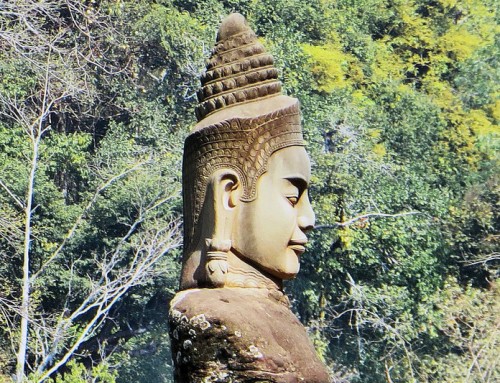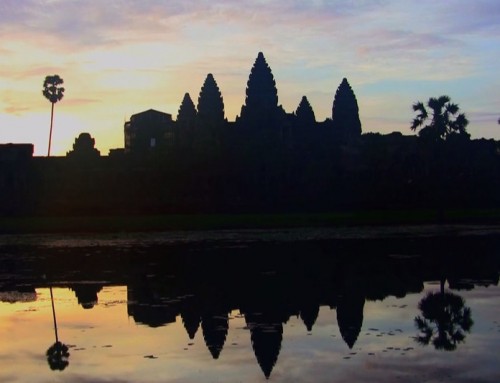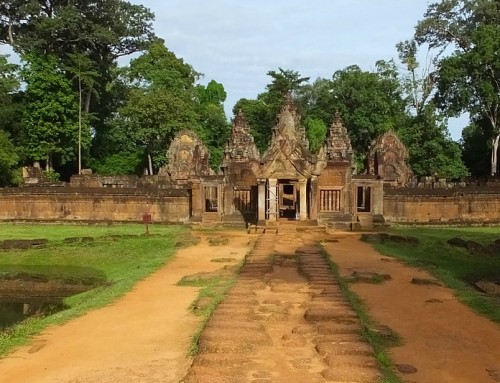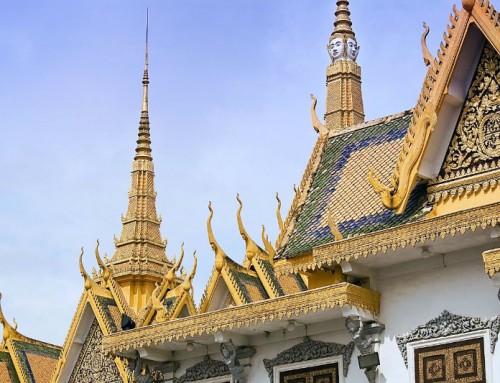
Day 01
Phnom Penh -, L, –
Arrival at Phnom Penh international airport and after immigration and customs formalities, meeting with the guide.
Transfer to hotel, where the check-in is generally provided at 14:00, however, if the rooms should be available before this time, guests will be accommodated as soon as possible.
Start of the introductory tour to the bustling capital of Cambodia passing between the colonial neighborhoods near the Independence Monument and continuing with a walk near the area where the three rivers converge almost in front of the Royal Palace. Visit the Wat Unalom, the famous pagoda in which he lives the great Venerable of the Buddhist monks.
Proceed to the famous Russian market, consisting of a series of intricate corridors and passages where a myriad of stalls and sellers may be overlooked and where all kinds of merchandise is displayed to potential buyers.
Lunch at local restaurant and dinner at leisure.
Overnight.
.
Day 02
Phnom Penh B, L, –
Breakfast at hotel.
Start the visit with the temple that gives the city its name, Wat Phnom: located atop a hill, attended by the faithful who come here to pray and get to predict the future by many fortune-tellers.
Then proceed to the Royal palace and Silver Pagoda, so called for more than five thousand silver tiles from which the floor is formed, all enriched by the gifts offered to the royal family from all over the world.
Proceed to the National Museum, built around 1918 and totally devoted to Khmer culture.
There are wonderful exhibits on display dating back to pre-Angkorian and Angkorian, including important Angkor statuary and many everyday objects found in various areas and eras.
Drive to the Toul Sleng, the prison museum tragic witness to the bloody regime of the Khmer Rouge and the genocide perpetrated against the Cambodian people themselves, guilty of being able to read and write, wear glasses, be teachers, doctors, professionals, speak foreign languages, it is estimated they have been tortured and killed about three million people over twelve in four years until 1979.
Lunch at local restaurant and dinner at leisure.
Overnight.
.
Day 03
Phnom Penh – Kratie B, L, –
Breakfast at hotel.
Departure to Kratie.
After about an hour drive, short break at Skhun village, famous for its edible giant spiders, cooked in many ways for whoever dares to taste them, which are served just in all ways to those who want it of course,.
Sellers turn their baskets to the sun in order not to cool delicious the food, offering delicate spiders, sold in small bags from which they may be taken and enjoyed one by one, as they were chips.
Visit the temple of Wat Nokor, dating from the eleventh century, a temple built with a modern Mahayana and Hinayana pagodas
Pass through vast rubber trees plantations, which are present in the area since the French colonial period, and stop to see the process of extraction of the substance.
Kratie is the province of the dolphin, and even if it is over 600 km. from the sea, the location is famous for being the city where there are more river dolphins that anywhere else in the world
Or so said a description of the colonial period, now maybe it is not more so, but there’ in any case the chance to meet the Irrawady river dolphins.
The town is big enough to have a couple of acceptable hotels and good restaurants which also provide European cuisine. In colonial times this was the capital of the whole north of the country and traces of this period are visible everywhere in the form of the roads and the residences of the lords of rubber. There are markets for all goods which remind us a bit of our emporiums time. Many traditional Khmer houses remind us of the ancient glories of this inland waterway market.
Departure to visit the side of the river where the largest number of dolphins gathers and boat trip in order to better approach and admire these so rare mammals.
Visit the town and its surroundings, then continue on seeing the temple of Phnom Sombok until sunset on the Mekong River.
Lunch at local restaurant and dinner at leisure.
Overnight.
.
Day 04
Kratie – Mondulkiri B, L, –
Breakfast at hotel.
Then start the journey to Mondulkiri
The trip runs entirely through a totally primordial jungle, one of the last remaining in South East Asia. The views of the completely pristine jungles and mountains will remain in the hearts of all the few adventurers who pass through these lands. Sen Monorom is the capital of the province of Mondulkiri. Located about 900 meters above sea level with its 6000 inhabitants, this is the smallest provincial capital of the country The province is very vast and since just a few years, the government is doing to encourage a policy of ‘migration in these areas.
Here again, the forests, the few remaining indigenous tribes and the many beautiful waterfalls surrounded by a primordial and untouched nature, are the attraction for the few who venture into these remote lands, still visited by a very low number of passengers willing to endure some discomfort in order to live a few days in one of the last unspoiled areas of the world.
The population of this vast province counts only about forty thousand inhabitants. The two main minority groups represent more than half of the population and this means that the Khmer are the minority in this province. Certainly many wild animals including tigers, bears, leopards, elephants, buffalo and who knows how many other live in these remote forests.
Lunch at local restaurant and dinner at leisure.
Overnight.
.
Day 05
Sen Monorom (Mondulkiri) B, L, –
Breakfast at hotel.
Visit an elephant conservation project. Elphant Valley Project.
Transfer to the project and then spend a morning with the elephants, following them into the jungle and learning to know them, seeing how drivers of local elephants behave in the forest and understanding conservation.
It is necessary to bring enough water (at least one liter) throughout the morning. It may also be necessary to wear sunscreen, a hat, a mosquito repellent, a waterproof jacket, etc.
You should wear appropriate clothing to staying in the jungle, such as long pants and a t-shirt.
Please do not wear shorts, short skirts, short skirts or dresses, visible neckties, straps, etc for respect for the local culture of Bunong staff who is employed in the project.
You need to wear suitable footwear, flip flops and slippers are not suitable for hiking in the forest.
Transfer to the beautiful Bousra Waterfall and chance to bath in the area.
Departure for a Phnong village situated about seven kilometers from town,
Lunch at local restaurant and dinner at leisure.
Overnight.
.
Day 06
Mondulkiri – Rattanakiri B, L, –
Breakfast at hotel.
Leaving for the province of Rattanakiri and arrival in the afternoon.
Banlung is the capital of the province of Rattanakiri. Vast plantations of rubber trees are nearby in a radius of at least fifteen Km.
In the most remote areas, the forest is still inhabited by large rare mammals such as tigesr, wild elephants, leopards, rhinos and even a kind of cow locally named Kouprey that seems to exist only in Cambodia. At several locations around the town there are places where precious stones are searched, generally zircons and garnets.
Waterfalls and volcanic lakes break up the great green forest where people can venture with confidence, for excursions on elephant back, on foot or by jeep, accompanied by the experienced rangers of the park. A volcanic crater lake is close to town that it could even be used as a pool. The lake is perfectly round shaped, is about 50 meters deep and the water on the surface is absolutely clear and transparent A volcanic crater lake is close to town that it could even be used as a pool. The lake which is perfectly round shaped, is about 50 meters deep and the water on the surface is absolutely clear and transparent. Escorted by the guides and in absolute safety it is possible to hike along the rivers and meet local tribe people with pre-Buddhist burial traditions unique in the world. They bury their dead by building monuments that are very similar to the deceased persons.
At Banlung market bows and arrows are still sold, new stuff, with no pretense of being tourist souvenirs, which shows that many forest peoples have not yet become farmers.
The whole area surrounding Banlung is full of eco-tourism opportunities. In the city there is also the chance to visit the interesting plant that starts the initial processing of the rubber formation.
Lunch at local restaurant and dinner at leisure.
Overnight.
.
Day 07
Rattanakiri B, L, –
Breakfast.
Depart towards the tribal cemeteries which are located north of Banlung. After about thirty kilometres board a boat along a tributary river of the Mekong and arrive at these minorities that keep absolutely unique rituals in the world and build equally unique tombs.
Return and visit the volcanic lakes, which are perfectly round with a depth of 50 meters and offer bathing possibilities.
Lunch en route and dinner at leisure.
Overnight.
.
Day 08
Rattanakiri – Stung Treng B, L, –
Breakfast at hotel.
Continue towards the province of Stung Treng, which is located on the way to Laos. It is a town without many pretensions, but a good base to make the trip to the waterfalls of the Mekong that are located a few kilometers from the border in Lao territory. At present they may be visited without obtaining a visa for Laos. The sight of these falls is truly impressive, the Mekong river plunges steeply down into a rocky gorge that falls for about twenty meters into the primordial forest. The 54 KM distance between the town and the falls may be travelled by fast boat and this would also be a part of this unforgettable trip.
Continue north to reach Preah Rumkel and continue to admire the rapids to observe the Sopheakmet waterfall, which has fired the great drawings of French imperialists and now marks the border with Laos. Along the way there is the opportunity to see Cambodian and Laotian fishermen and know their fishing style. There are several places to watch the falls, according to the time of the year. The guide will make the decision based on current circumstances. Going south we will begin the Mekong descent where we will continue our tour to explore the flooded Mekong wetland forests, Ramsa. It extends south along the Mekong River, from the border with Laos to Stung Treng.
Accessible only by boat, it is a paradise for mammals, birds and fish, it is unique river forest ecosystem, the dream of every naturalist photographer. Near the bungalows you will find the kayaks and weather permitting will be ‘possible to visit along the river in places accessible only by boat,
Time to enjoy the nature that surrounds the site.
Lunch en route and dinner at leisure.
Overnight.
.
Day 09
Stung Treng – Pre Vihear B, L, –
Departure towards the area of Pre Vihear.
The territory on which the temple stands has long been disputed between Cambodia and Thailand.
until, in 1963, an international court attributed it to Cambodia.
The location of the temple, exactly on the mountain crest, from which you can enjoy breathtaking views of Cambodia, Thailand and even Laos, It puts it in an absolutely distinct category compared to all the Khmer Temples.
The temple is made up of a large complex built on four levels, comprising five entrance halls ( Gopura ) and a Royal Residence with two wings, which probably also served as shelter for pilgrims.
Between one and the Gopura ‘There are other long courtyards flanked by Naga and at the side of one of them there is the large tank of water which served pilgrims and inhabitants of the temple.
The construction of the whole complex has been going on for over two hundred years as of the end of the ninth century, a time when Koh Ker ‘was the capital of the Khmer kingdom (921-942).
In 2004 the government of Phnom Phen has opened a new road from the valley floor which adds to the old road built by the Khmer Rouge In the mid-1980s, in the mid of the civil war.
This made the access to the temple relatively easy also from the Cambodian side.
The excursion to the temple of Prasat Phre Viher will be truly unique and unforgettable.
Lunch at local restaurant and dinner at leisure.
Overnight.
.
Day 10
Pre Vihear – Ko Ker – Beng Melia – Siem Reap B, L, –
Breakfast at hotel.
Departure and arrival in Ko Ker, which is another complex of many temples and monasteries, the most important of which contains a large pyramid of seven steps which leaves very puzzled by the similarity with other sites of that period, many thousands of miles away.
Koh Ker was the capital of the Khmer empire for twenty years, in the ninth century. Now many of the ruins are still being immersed in the jungle and seldom visited, they are able to retransmit that particular charm that stunned the visitors a few decades ago and left them speechless.
At about seventy kilometers from Ko Ker stands the largest complex of Beng Melea, a temple with an adjoining monastery nestled in the jungle, which covers an area of over one square km.
Built in the same style and by the same king who built Angkor Wat, Beng Melea is considered by many may actually also to have been a prototype of the great temple.
Being devoid of carvings, it is thought to have been completed painted to be ‘internal to’ outside.
Most of the monastic complex has not been restored and the atmosphere is fantastic.
With the exception of the Ta Phrom, this complex offers the best shots of vegetation and large trees integrated into the temple.
Departure and arrival in Siem Reap.
Lunch en route and dinner at leisure.
Overnight.
.
Day 11
Siem Reap B, L, –
Breakfast at hotel.
Departure for the visit of the pre-Angkorian Rolous archaeological complex, located about 15 km south-east from the town.
The temples of Prae Ko, Bakong and Lolei are the main and first to be built in the area during the ninth century, they represent the link between the kingdom of Chenla, whose capital were situated where now there are the remains of Sambor Preikuk and the new kingdom of Angkor, marking the beginning of the summit of power and Khmer art.
Then proceed to the Angkor complex and see the Prasat Kravan, the only example a the temple that consists of five towers in the line. In the middle see one of the most beautiful decorations dedicated to the god Vishnu.
In the afternoon visit the walled city of Angkor Thom, passing through the South Gate, and continuing to the spectacular temple of Bayon, which, with its more than two hundred enigmatic faces, is the central building, both in the location and in the design of the city itself.
It is a masterpiece from the amazing structure consisting of 54 towers and has beautiful bas-relief depicting the daily life at the time of the kingdoms of Angkor and in which they were counted more than ten thousand figures carved in stone.
Then continue by passing in front of the imposing Baphuon and see the pyramid-shaped temple linked to the legend and the king and the snake, Pimeanakas, then to the area where the Royal Palace was located and end with the beautiful Terrace of the Elephants and Leper King.
Lunch at local restaurant and dinner at leisure.
Overnight.
.
Day 12
Siem Reap B, L, –
Breakfast at hotel.
Excursion to discover the Bantey Srey temple, which means the citadel of women, famous for the beautiful bas-reliefs carved in almost all pink sandstone and considered by many, even greater delicacy and precision to those found in Angkor Wat.
The temple is located about 40 km from Siem Reap and it is reached while passing through an enchanting landscape characterized by rice fields and villages.
Before returning, visit the temple of Bantey Samre, named after the legend of the peasant who became king.
In the afternoon proceed to the Bantey Kdey temple, also called the citadel of the cells that served as a meditation retreat for Buddhist monks. After admiring the reservoir of Shree Shrang or royal bath, climb the mountain temple of Pre Rup that marks the beginning of a new era in the Khmer architecture. It is built in red bricks and it is’ particularly impressive at sunset time, when the reddish bricks are constantly changing their colours.
Lunch at local restaurant and dinner at leisure.
Overnight.
.
Day 13
Siem Reap B, L, –
Breakfast at hotel.
Part of the morning spent at Angkor Wat, the masterpiece of all Khmer art, the most famous and impressive temple in the area, considered one of the wonders of the world.
It is a structure that dazzles in its spectacular, extraordinary example of architectural wisdom, decorated with extremely refined sculptures and bas-reliefs, through which the main scenes of the Indian epics are described in masterly fashion.
In the afternoon proceed to visit part the Grand Circuit of Angkor, beginning with the vast and majestic temple of Prae Khan, also known as the temple of the Holy Sword, which had the functions of a religious and cultural centre and, for a period, it was also used as royal residence. At its maximum development, more than ten thousand people were living in the compound, including many of the important teachers and the Apsara dancers, the celestial dancers.
Continue to Neak Pean, the only circular structure in memory of a mythical lake which arise from the four rivers of Hindu mythology. At the time this sacred space was used as a place of purification by water.
Then head to one of the most suggestive and fascinating temples, the Ta Phrom,
It is totally immersed in the jungle and deliberately left in same condition as when it was discovered by French archaeologists in 1860.
Partially covered by vegetation, the roots of trees magically embrace the sculptures and stone blocks of galleries, signing a marriage between history and the unbridled force of nature itself.
Lunch at local restaurant and dinner at leisure.
Overnight.
.
Day 14
Siem Reap B, –
Breakfast at hotel.
The Angkor National Museum is the one and only world class museum in Siem Reap that enhances the cultural heritage of the golden era of the Khmer Kingdom through a collection of priceless artefacts and technologically advanced multimedia exhibitions that lead to full and immediate understanding.
The museum is an important inspirational site of art, culture and history of the legendary Khmer ancient civilization.
Lunch at local restaurant.
Transfer to the airport in time for the departure of the scheduled flight.
End of services.
-
Transfers and excursions by air conditioned private vehicles as per program, except where open line boats are provided.
-
Private English speaking guides, other languages with supplement.
-
Assistance, availability and regular visits to customers by dedicated and resident staff.
-
Entrance fees.
-
Accommodation as per requested hotels.
-
Meals as per program.
-
New taxes and entrance fees.
- Any kind of insurances
- Drinks at meals (if any) and extras in general





